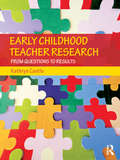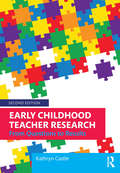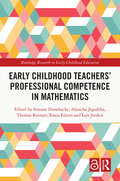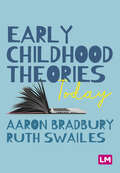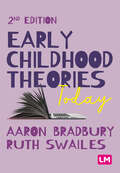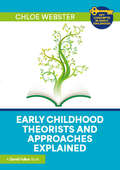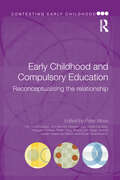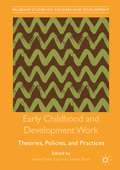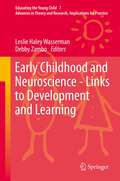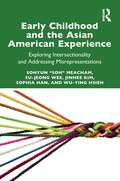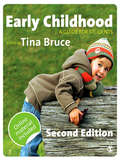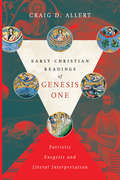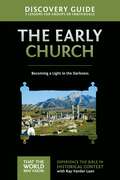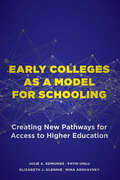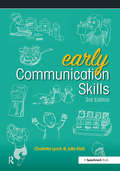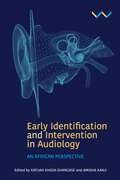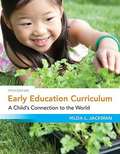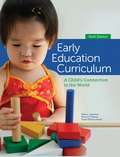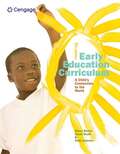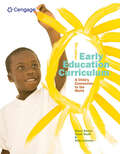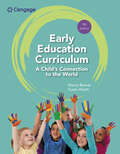- Table View
- List View
Early Childhood Teacher Research: From Questions to Results
by Kathryn CastleWhat is early childhood teacher research and why is it important? How does a teacher researcher formulate a research question and a plan for doing research? How do teachers apply research results to effect change? Early Childhood Teacher Research is an exciting new resource that will address the sorts of questions and concerns that pre- and in-service teachers of young children frequently have when engaging in teacher research. Accessible and interactive, this book touches upon the important issues every early childhood teacher should know—the uniqueness of early childhood teacher research, reasons for doing it, and how to do it. In this comprehensive guide, Kathryn Castle explores each stage of teacher research, from conceptualization, generating research questions, identifying data sources, gathering and analyzing data, interpreting results, sharing results, to taking action based on results. Special features included in each chapter: Teacher Researcher Journal prompts for the reader to record ideas for research questions and to develop a plan for doing research. From the Field provides rich examples of real life early childhood teacher researchers and their perspectives on doing teacher research. Reflections ask readers to pause and think deeply about relating content to their own situations. Exploration of additional content, websites, resources, and activities are located in each chapter to help the reader go further in constructing their knowledge of teacher research.
Early Childhood Teacher Research: From Questions to Results
by Kathryn CastleIn this fully revised and updated second edition, Early Childhood Teacher Research addresses the questions and concerns that pre- and in-service teachers of young children frequently have when engaging in teacher research. Accessible and interactive, this book explores the important issues every early childhood teacher should know, guiding readers from conceptualization, generating research questions, identifying data sources, gathering and analyzing data, interpreting and sharing results, to taking action. This second edition features thoroughly updated references, standards, and resources, as well as all-new sections on teacher advocacy, social media and devices, data collection, and planned versus unplanned research. Each chapter features: Teacher Researcher Notebook prompts for the reader to record ideas for research questions and to develop a plan for doing research. “From the Field” vignettes providing rich examples of real-world early childhood teacher researchers and their perspectives on doing teacher research. Reflection prompts inviting readers to pause and think deeply about relating content to their own situations. Reflections can be recorded in the Teacher Researcher Notebook. Explorations of additional content, websites, resources, interviews, and activities.
Early Childhood Teachers‘ Professional Competence in Mathematics (Routledge Research in Early Childhood Education)
by Thomas Koinzer Katja Eilerts Simone Dunekacke Aljoscha Jegodtka Lars JenßenThis edited volume presents cutting-edge research on the professional competence of early childhood mathematics teachers. It considers professional knowledge, motivational-affective dispositions, skills and performance in early childhood mathematics and outlines future fields of research in this area. The book argues that it is essential for early childhood teachers to prepare a high-quality learning environment and that mathematical competence is highly relevant for children’s individual development. Bringing together research from mathematics education, educational science and psychology, it integrates international perspectives and considers the contextual factors that affect the development of children’s mathematical competence within Early Childhood Education and Care (ECEC) settings. The book uses a model to describe professional teacher competence that considers the dispositions of early childhood teachers, situation-specific skills of early childhood teachers and the performance of early childhood teachers. The book is the first of its kind to give a comprehensive overview and allows for integrative perspectives and interdisciplinary understanding regarding pre- and in-service ECEC teachers’ professional competence in the domain of mathematics. It will be essential reading for academics, researchers and students of early childhood education, mathematics education and teacher education.
Early Childhood Theories Today
by Aaron Bradbury Ruth SwaliesIf you work in the early years, you have probably heard of Montessori and Bronfenbrenner - but have you heard of Bavolek or Fisher? Contemporary theorists and theories of early childhood learning have much to teach us. It is often forgotten that this learning is still evolving and that new voices are joining the discussion every year. This book introduces early years practitioners to some contemporary theorists and explores their work alongside more well-known thinkers. It demonstrates how these theories relate to everyday practice in the early years and that discussion of them can support ongoing professional learning.
Early Childhood Theories Today
by Aaron Bradbury Ruth SwaliesIf you work in the early years, you have probably heard of Montessori and Bronfenbrenner - but have you heard of Bavolek or Fisher? Contemporary theorists and theories of early childhood learning have much to teach us. It is often forgotten that this learning is still evolving and that new voices are joining the discussion every year. This book introduces early years practitioners to some contemporary theorists and explores their work alongside more well-known thinkers. It demonstrates how these theories relate to everyday practice in the early years and that discussion of them can support ongoing professional learning.
Early Childhood Theories Today
by Aaron Bradbury Ruth SwailesIf you work in the early years, you have probably heard of Montessori and Bronfenbrenner - but have you heard of Bavolek, Fisher or Page? Contemporary theorists and theories of early childhood learning have much to teach us. It is often forgotten that this learning is still evolving and that new voices are joining the discussion every year. With new chapters on Maslow, Bowlby, Piaget and Vygotsky, this second edition introduces you to some contemporary theorists and explores their work alongside more well-known thinkers. It demonstrates how these theories relate to everyday practice in the early years and that discussion of them can support ongoing professional learning.
Early Childhood Theories Today
by Aaron Bradbury Ruth SwailesIf you work in the early years, you have probably heard of Montessori and Bronfenbrenner - but have you heard of Bavolek, Fisher or Page? Contemporary theorists and theories of early childhood learning have much to teach us. It is often forgotten that this learning is still evolving and that new voices are joining the discussion every year. With new chapters on Maslow, Bowlby, Piaget and Vygotsky, this second edition introduces you to some contemporary theorists and explores their work alongside more well-known thinkers. It demonstrates how these theories relate to everyday practice in the early years and that discussion of them can support ongoing professional learning.
Early Childhood Theorists and Approaches Explained (Key Concepts in Early Childhood)
by Chloe WebsterThis new book provides accessible explanations of the key theories, concepts, and approaches that form the foundations of early childhood education. Unpicking terms like "attachment," "constructivism," and "heuristic play" and introducing both established and less-known contemporary theorists, it is designed to be an easy and comprehensive guide to early childhood theories and approaches, an often complex topic to understand and explore fully.The book is divided into two parts. The first provides a brief overview of the theorists and approaches, both historical and modern, with explanations, backgrounds, benefits, and criticisms where appropriate. It also defines key terms used in theory and research alongside examples of how they work in practice. Part 2 looks more broadly at how these theories and approaches have been incorporated into settings and present-day policies. The chapters also offer insights from practitioners on how the theories are used successfully and how different countries and cultures adopt and implement particular approaches.This latest book in the Key Concepts in Early Childhood Series is essential reading for early years practitioners and students who want to support their studies and deepen their understanding, as it makes the pedagogical theories behind the early years curriculum and framework easy to understand and apply.
Early Childhood Voices: Children, Families, Professionals (International Perspectives on Early Childhood Education and Development #42)
by Andi Salamon Sharynne McLeod Linda Mahony Jenny DwyerThis revolutionary book explores theoretical and practical issues of listening to children, families, and professionals who advocate for and work with young children to promote social justice and improve their lives, and to ensure no one is left behind. Listening to children is explored across multiple disciplines internationally and highlights the practical application of the United Nations Sustainable Development Goals in the context of the Convention on the Rights of the Child. The work explores innovations, theories, and partnerships, and draws on the voices of children, families, early childhood educators, speech-language pathologists, and multidisciplinary teams from across 17 countries to provide a shared vision for equity, peace and justice for all while integrating social environmental, economic, and dimensions of sustainability. Topics include giving children a voice; methods for listening to and documenting young children’s perspectives; listening to and working in partnership with families, educators, and professionals; and wellness and wellbeing of young children and their families across multiple dimensions.
Early Childhood and Compulsory Education: Reconceptualising the relationship (Contesting Early Childhood)
by Peter MossWhat should be the relationship between early childhood and compulsory education? What can they learn from one another and by working together? The rapid expansion of early childhood education and care means that most children in affluent countries now have several years at pre-school before compulsory education. This raises an important question about the relationship between the two.? Whilst it’s widely assumed that the former should prepare children for the latter, there are alternatives. This book contests the ‘readying for school’ relationship as neither self-evident nor unproblematic; and explores some alternative relationships, including a strong and equal partnership and the vision of a meeting place. In this ground-breaking book, Professor Peter Moss discusses the issue with leading early childhood figures - from Belgium, France, Italy, New Zealand, Norway, Sweden and the United States -who bring very different perspectives to this contentious relationship.? The book starts with an extended essay by Peter Moss, to which the other contributors are invited to respond critically, as well as offering their own thinking about the relationship between early childhood and compulsory education, both their current understandings and suggestions on future directions. Students, researchers and academics in the field of early childhood education will find this an insightful and timely text. But so too will their peers in compulsory education, since the book time and again raises searching questions about pedagogical purpose and practice in this sector.
Early Childhood and Development Work: Theories, Policies, and Practices (Palgrave Studies on Children and Development)
by Helen Penn Anne-Trine KjørholtThis edited volume provides a critical account of the theories and policies that have informed work in the field of early childhood and explores how they have operated in practice. Underpinning the theoretical debates are the familiar tensions between global norms and local contexts; increasing inequality alongside economic progress, and the increasing prominence of business and the private sector in delivering aid programs. The authors offer a profound critique on an increasingly important topic and discuss alternative models of policy and practice.
Early Childhood and Neuroscience - Links to Development and Learning
by Leslie Haley Wasserman Debby ZamboInformation from neuroscience is growing and being properly used, and misused wich makes it imperative that educators receive accurate and practical information. This book provides the accurate and practical information educators (pre-service and in-service) and caregivers serving children birth through age 8 need to know. This volume takes a practical and cautionary stance. It reminds educators to consider the ethical implications of neuroscience when it is applied to education, reviews current findings from neuroscience and reveals the dangers of oversimplification and inappropriate extensions of neuroscience into curricula. It brings together a group of authors with varied expertise writing on an array of inter-related educational topics that will help educators use neuroscience to understand and address the cognitive, emotional, social, and behavioral needs of all young children, including those with exceptionalities. They believe neuroscience can be insightful and useful to educators if applied ethically and with care. The book offers strategies educators and caregivers can use to affect children today and the adults they can become.
Early Childhood and the Asian American Experience: Exploring Intersectionality and Addressing Misrepresentations
by Sohyun "Soh" Meacham Su-Jeong Wee Jinhee Kim Sophia Han Wu-Ying HsiehThis essential and urgent book presents research-based understandings about Asian American early childhood, bringing to light the battle Asian Americans face against American nativism from their early years’ experiences. The first of its kind in academic literature, the book addresses the well-known issue of underrepresentation of Asian Americans in early childhood education research and practice, and in American society in general. Using the intersectionality and multiple identities perspectives, the authors explore a myriad of inaccurate cultural perceptions and misrepresentations, centering within-group differences among Asian American children and giving particular attention to disempowered groups among them. Issues related to socioeconomic status, gender, dis/abilities, linguistic backgrounds, and minority groups among Asian American populations are addressed, with implications for researchers and educators as well as context for examining the policies that cause inequities among Asian American children. This book is key reading for early childhood education researchers, professors, and graduate students to become more productively engaged in discussions and practices toward racial justice.
Early Childhood: A Guide for Students
by Tina BruceDesigned for students on Early Years Foundation Degrees and Early Childhood courses, Early Years professionals and Teaching Assistants, this engaging text provides a comprehensive introduction to the field of early childhood. Written and edited by experts in the field, the book clearly explains theory through illustrations of good practice, with case studies, reflective exercises and suggestions for further reading. Additional case studies and reflective questions for student or lecturer's use can be found on the SAGE website. Each chapter has been revised with an emphasis on encouraging reflective practice and there are new chapters on: - personal, social, and emotional development - EYPS - health and safeguarding children This brand new edition has also been updated in light of the new Early Years Foundation Stage, and addresses the needs of students working towards Early Years Professional Status (EYPS).
Early Christian Readings of Genesis One: Patristic Exegesis and Literal Interpretation (Biologos Books on Science and Christianity)
by Craig D. AllertDo the writings of the church fathers support a literalist interpretation of Genesis 1? Young earth creationists have maintained that they do. And it is sensible to look to the Fathers as a check against our modern biases. But before enlisting the Fathers as ammunition in our contemporary Christian debates over creation and evolution, some cautions are in order. Are we correctly representing the Fathers and their concerns? Was Basil, for instance, advocating a literal interpretation in the modern sense? How can we avoid flattening the Fathers' thinking into an indexed source book in our quest for establishing their significance for contemporary Christianity? Craig Allert notes the abuses of patristic texts and introduces the Fathers within their ancient context, since the patristic writings require careful interpretation in their own setting. What can we learn from a Basil or Theophilus, an Ephrem or Augustine, as they meditate and expound on themes in Genesis 1? How were they speaking to their own culture and the questions of their day? Might they actually have something to teach us about listening carefully to Scripture as we wrestle with the great axial questions of our own day? Allert's study prods us to consider whether contemporary evangelicals, laudably seeking to be faithful to Scripture, may in fact be more bound to modernity in our reading of Genesis 1 than we realize. Here is a book that resets our understanding of early Christian interpretation and the contemporary conversation about Genesis 1.
Early Church Discovery Guide: Becoming a Light in the Darkness (That the World May Know)
by Ray Vander Laan Stephen And SorensonThis five-session small group Bible study (DVD/digital video sold separately) by noted teacher and historian, Ray Vander Laan, is volume five of the That the World May Know series. In this volume, Vander Laan uncovers the passion and commitment early believers displayed as they claimed Jesus in the face of fierce consequences and powerful adversaries. Faith Lessons is a unique video series that brings God's Word to life with astounding relevance. By weaving together the Bible's fascinating historical, cultural, religious, and geographical contexts, teacher and historian Ray Vander Laan reveals unique insights into the Scriptures' significance for modern believers. Filmed on location in Caesarea Philippi, Sardis, Pergamum, Ephesus, and Laodicea, these illuminating "faith lessons" afford a new understanding of the Bible that will ground your convictions and transform your life. The Faith Lessons video series is ideal for use in small groups, personal and family Bible studies, and adult Sunday school. Individual believers and families will gain vital insights from long-ago times and cultures through this innovative approach to Bible study. Lessons include: Everything to Lose, Nothing to Gain – Filmed in Caesarea Philippi The Salt of the Earth – Filmed in Sardis Where Satan Lives – Filmed in Pergamum The Mark of the Beast – Filmed in Ephesus Hot or Cold – Filmed in Laodicea Designed for use with the Early Church Video Study (sold separately).
Early Colleges as a Model for Schooling: Creating New Pathways for Access to Higher Education
by Julie A. Edmunds Fatih Unlu Elizabeth J. Glennie Nina ArshavskyEarly Colleges as a Model for Schooling advocates for early college high schools as an effective means of reducing academic, cultural, and financial obstacles to postsecondary education.This perceptive work evaluates, both quantitatively and qualitatively, the impacts of early colleges—hybrids that blend elements of secondary and postsecondary education. It examines the strengths and challenges of early college models of different designs and explores their place in the greater education system.Julie A. Edmunds, Fatih Unlu, Elizabeth J. Glennie, and Nina Arshavsky craft their narrative around the findings of one of the most ambitious studies to date on early college high schools, a fifteen-year longitudinal study involving more than four thousand students across nineteen secondary schools that have adopted the model. They offer insight into the student experience within early college high schools and beyond.The authors demonstrate how the well-structured and supportive educational environment of early college not only prepares students academically for college-level coursework but also helps students navigate logistical challenges in applying for colleges and universities. They show how the positive outcomes of the early college experience can help tip the balance toward successful postsecondary educational experiences, especially for historically underserved students such as low-income students, minority students, and first-generation college students.As the authors point out, a shift in the way the transition between secondary and postsecondary education is implemented provides an achievable approach to improving college readiness and lowering educational barriers. They argue persuasively that wider adoption of this educational model in high schools has great potential to improve overall access to higher education.
Early Communication Skills: 3rd edition (Early Skills)
by Charlotte Lynch Julia Kidd'Early Communication Skills' has been a popular and widely used publication since becoming available in 1991. Now in its third edition, the resource retains its original approach to communication, providing a source of fresh educational and therapeutic ideas for pre-school children. Special features: a question and answer section designed to answer all common concerns; exercise and worksheets; over 100 activities are provided, spanning all areas of communication from pre-verbal skills to early words. Charlotte Lynch, Paediatric Speech and Language Therapist. Julia Kidd, Paediatric Speech and Language Therapist.
Early Congresses (Social Studies Readers)
by Wendy ConklinThis nonfiction book invites readers to learn about the very first United States Congress and government. Readers will learn about colonists' frustrations with the British and what caused them to create the First and Second Continental Congress, Committees of Correspondence, and the Declaration of Independence. With plenty of colorful images, easy-to-read text, and engaging sidebars, readers will be fascinated from cover to cover as they are introduced to the three branches of U.S. government--executive, legislative, and judicial. A glossary and table of contents are provided for assistance for better understanding the content.
Early Detection and Intervention in Audiology: An African perspective
by Katijah Khoza-Shangase, Amisha KanjiA textbook with case studies for audiologists and speech pathologists to make recommendations for early detection and intervention of hearing impairments in the South African contextEarly hearing detection and intervention (EHDI) is the gold standard for any practicing audiologist, and for families of infants and children with hearing impairment. EHDI programs aim to identify, diagnose and provide intervention to children with hearing impairment from as early as six months old (as well as those at risk for hearing impairment) to ensure they develop and achieve to their potential. Yet EHDI remains a significant challenge for Africa, and various initiatives are in place to address this gap in transferring policy into practice within the southern African context. The diversity of factors in the southern African context presents unique challenges to teaching and research in this field, which has prompted this book project. The South African government’s heightened focus on increasing access to health care which includes ongoing Early Childhood Development (ECD) programs, make this an opportune time for establishing and documenting evidence-based research for current undergraduate and postgraduate students. Early Detection and Intervention in Audiology: An African Perspective aims to address this opportunity. Grounded in an African context with detailed case studies, this book provides rich content that pays careful attention to contextual relevance and contextual responsiveness to both identification and intervention in hearing impairment. With diverse contributions from experts in local and international contexts, but always with an African perspective, this is textbook will be an invaluable resource for students, researchers and practitioners.
Early Education Curriculum: A Child's Connection to the World (5th Edition)
by Hilda L. JackmanThe Fifth Edition of EARLY EDUCATION CURRICULUM: A CHILD'S CONNECTION TO THE WORLD focuses on the process of planning and implementing a curriculum, and setting up an inclusive child-centered environment. Guided by new research, position statements, and developmentally appropriate practice, the book helps both prospective and experienced teachers make informed decisions about curriculum content. Now in full color, the book meets the needs of a diverse range of readers, helping them to develop creative thinking and the ability to effectively apply theory to an early childhood classroom setting.
Early Education Curriculum: A Child's Connection to the World, Sixth Edition
by Hilda Jackman Nancy Beaver Susan WyattThe sixth edition of EARLY EDUCATION CURRICULUM: A CHILD'S CONNECTION TO THE WORLD focuses on the process of planning and implementing a curriculum, and setting up an inclusive child-centered environment. This book helps users learn to make informed decisions about curriculum content as well as to develop creative thinking and the ability to effectively apply theory to an early childhood classroom setting. Updated to include the most current research and standards, the sixth edition presents new material on brain research that underlies teaching ideas as well as new information on reflective practice, intentional teaching, and using the environment as a teaching tool. The book retains its strong applied focus on the how-to's of teaching, with many new hands-on teaching tips and six new chapters on topics such as observation and assessment, fine motor and manipulatives, and large motor and outdoor play.
Early Education Curriculum: A Child’s Connection to the World
by Hilda Jackman Nancy Beaver Susan WyattEARLY EDUCATION CURRICULUM: A CHILD'S CONNECTION TO THE WORLD shows you how to conduct observations and assessments of children and the program, plan and implement a curriculum, set up an inclusive child-centered environment, and evaluate and document program quality and children's learning. Whether you are a student or an experienced teacher, this book will help you learn how to make informed decisions about curriculum content as well as to develop creative thinking skills and effectively apply theory to an early childhood classroom setting. Updated with the most current research and standards, the seventh edition presents new material on brain research that underlies teaching ideas as well as new information on reflective practice, intentional teaching, and using the environment as a teaching tool. Case studies allow you to apply your knowledge to solve real-life dilemmas. The book's strong applied approach focuses on the how-to's of teaching, with many hands-on teaching tips.
Early Education Curriculum: A Child’s Connection to the World
by Hilda L. Jackman Nancy H. Beaver Susan Skinner WyattEARLY EDUCATION CURRICULUM: A CHILD'S CONNECTION TO THE WORLD focuses on the role of observation and assessment in early childhood programming, the process of planning and implementing a curriculum, setting up an inclusive child-centered environment, and the uses of evaluation and documentation for continuous program improvement. Updated with current research and standards, the text continues to present new material on brain research that underlies teaching ideas as well as information on reflective practice, intentional teaching, and using the environment as a teaching tool. The seventh edition includes more material on diversity and diversity strategies, activity plans for different age groups, and more floor plans. New case studies provide examples of how activities planned align with specific standards, and allow students to apply knowledge gained to real-life situations. The book retains its strong applied focus on the how-to's of teaching, with many hands-on teaching tips.
Early Education Curriculum: A Child’s Connection to the World
by Nancy H. Beaver Susan Skinner WyattPacked with hands-on tips, Beaver/Wyatt's EARLY EDUCATION CURRICULUM: A CHILD'S CONNECTION TO THE WORLD, 8th Edition, shows you how to conduct observations and assessments, plan and implement a curriculum, set up an inclusive child-centered environment, plan developmentally appropriate activities in 11 subject areas and use technology in early learning programs. Students and experienced teachers alike will learn how to make informed decisions about curriculum content, develop creative thinking skills and effectively apply development and learning theory. Updated with the latest research and national standards, the 8th Edition presents material on brain research that underlies teaching ideas as well as information on reflective practice, intentional teaching, the environment as a teaching tool and equity and diversity. Case studies enable you to apply your knowledge to real-life issues.
